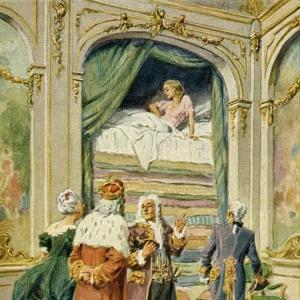Reading time: 7 min
Once upon a time there was an old poet, one of those right good old poets. One evening, as he was sitting at home, there was a terrible storm going on outside. The rain was pouring down, but the old poet sat comfortably in his chimney-corner, where the fire was burning and the apples were roasting.
“There will not be a dry thread left on the poor people who are out in this weather,” he said. “Oh, open the door! I am so cold and wet through,” called a little child outside. It was crying and knocking at the door, whilst the rain was pouring down and the wind was rattling all the windows.
“Poor creature!” said the poet, and got up and opened the door. Before him stood a little boy; he was naked, and the water flowed from his long fair locks. He was shivering with cold; if he had not been let in, he would certainly have perished in the storm.
“Poor little thing!” said the poet, and took him by the hand. “Come to me; I will soon warm you. You shall have some wine and an apple, for you are such a pretty boy.” And he was, too. His eyes sparkled like two bright stars, and although the water flowed down from his fair locks, they still curled quite beautifully.
He looked like a little angel, but was pale with cold, and trembling all over. In his hand he held a splendid bow, but it had been entirely spoilt by the rain, and the colours of the pretty arrows had run into one another by getting wet.
The old man sat down by the fire, and taking the little boy on his knee, wrung the water out of his locks and warmed his hands in his own. He then made him some hot spiced wine, which quickly revived him; so that with reddening cheeks, he sprang upon the floor and danced around the old man.
“You are a merry boy,” said the latter. “What is your name?” – “My name is Cupid,” he answered. “Don’t you know me? There lies my bow. I shoot with that, you know. Look, the weather is getting fine again—the moon is shining.” – “But your bow is spoilt,” said the old poet.
“That would be unfortunate,” said the little boy, taking it up and looking at it. “Oh, it’s quite dry and isn’t damaged at all. The string is quite tight; I’ll try it.” So, drawing it back, he took an arrow, aimed, and shot the good old poet right in the heart. “Do you see now that my bow was not spoilt?” he said, and, loudly laughing, ran away. What a naughty boy to shoot the old poet like that, who had taken him into his warm room, had been so good to him, and had given him the nicest wine and the best apple!
The good old man lay upon the floor crying; he was really shot in the heart. “Oh!” he cried, “what a naughty boy this Cupid is! I shall tell all the good children about this, so that they take care never to play with him, lest he hurt them.” And all good children, both girls and boys, whom he told about this, were on their guard against wicked Cupid; but he deceives them all the same, for he is very deep.
When the students come out of class, he walks beside them with a book under his arm, and wearing a black coat. They cannot recognize him. And then, if they take him by the arm, believing him to be a student too, he sticks an arrow into their chest. And when the girls go to church to be confirmed, he is amongst them too.
In fact, he is always after people. He sits in the large chandelier in the theatre and blazes away, so that people think it is a lamp; but they soon find out their mistake. He walks about in the castle garden and on the promenades. Yes, once he shot your father and your mother in the heart too. Just ask them, and you will hear what they say.
Oh! he is a bad boy, this Cupid, and you must never have anything to do with him, for he is after every one. Just think, he even shot an arrow at old grandmother; but that was a long time ago. The wound has long been healed, but such things are never forgotten. Now you know what a bad boy this wicked Cupid is.
 Learn languages. Double-tap on a word.Learn languages in context with Childstories.org and Deepl.com.
Learn languages. Double-tap on a word.Learn languages in context with Childstories.org and Deepl.com.Backgrounds
Interpretations
Linguistics
„The Saucy Boy“ is a whimsical fairy tale by Hans Christian Andersen that presents a unique portrayal of Cupid, the mythical god of love, in a humorous and somewhat ironic light. The story unfolds on a stormy night when an old poet hears a child’s cry for help outside his door. Upon offering shelter, the poet finds a beautiful, albeit shivering, naked little boy with a bow, who introduces himself as Cupid.
The poet shows kindness and hospitality, warming the boy by the fire and providing him with food and drink. However, once revived, Cupid mischievously shoots the poet in the heart with his bow, revealing that his weapon is far from ruined by the rain. Despite the poet’s generosity, Cupid flees, leaving the poet to lament being wounded by the very boy he aided.
The tale humorously warns the audience—particularly children—about the unpredictable and mischievous nature of Cupid, suggesting he can appear anywhere and target anyone with his arrows, symbolizing irresistible love and attraction. Cupid’s antics are shown to play out in various settings, including schools, churches, and public spaces, affecting students, churchgoers, and even family members across generations.
Andersen’s story, with its playful narrative, cautions against the troublesome nature of love embodied by Cupid, who, despite his seemingly innocent appearance, brings unexpected chaos to people’s lives. The story reflects on the unpredictability and ubiquity of love, suggesting that it can strike anyone at any time, often when least expected.
„The Saucy Boy“ by Hans Christian Andersen is a whimsical yet thought-provoking fairy tale that can be interpreted through various lenses.
Personification of Love: The story uses Cupid, the Roman god of love, as an allegory for the unpredictable and sometimes painful nature of love. The old poet, representing wisdom and kindness, is unexpectedly struck by love’s arrow, symbolizing how love can strike at any moment and to anyone, regardless of age or wisdom. This emphasizes the unpredictable and uncontrollable nature of love.
The Duality of Innocence: At first glance, the little boy appears innocent and helpless, eliciting sympathy and care. However, he turns out to be mischievous and even harmful. This duality highlights the theme that appearances can be deceptive, and what seems harmless can sometimes cause pain or trouble. It can be a reminder that even the purest forms of affection, like love, carry the potential for heartache.
Betrayal and Kindness: The story juxtaposes the kindness of the poet with the betrayal by Cupid. Despite the poet’s hospitality, Cupid shoots him with an arrow, exploring themes of trust and betrayal. It shows that acts of kindness do not always guarantee reciprocation and that vulnerability can sometimes lead to unexpected hurt.
The Omnipresence of Love: Cupid is depicted as being everywhere, targeting students, people at the theater, and even family members. This can be interpreted as love being a universal experience that affects everyone, regardless of time or place. It’s a force that is both personal and communal, touching every person’s life in some way.
Cautionary Tale: On a surface level, the story serves as a cautionary tale for children, warning them about the mischievous nature of Cupid. It suggests that one should be wary of getting too close or being too trusting, a lesson in understanding that love can be both beautiful and wounding.
Romantic Relationships Over Generations: The story might also comment on the enduring nature of romantic relationships across generations. By suggesting that Cupid has even targeted the listeners‘ parents and grandparents, Andersen is illustrating how romantic love is a common thread that ties different generations together, with each experiencing love’s joys and woes.
Overall, Andersen’s tale weaves a myriad of emotions and themes, leading to rich interpretations on love, trust, innocence, and the nature of human relationships.
Hans Christian Andersen’s „The Saucy Boy“ is a compelling fairy tale that can be explored through various linguistic and thematic lenses.
Characterization: The old poet: is depicted as kind and compassionate, showcasing typical traits of benevolence and hospitality. The linguistic choices here, such as „good old poets“ and phrases expressing concern for those out in the storm, highlight his warmth and kindness.
Cupid: , on the other hand, is introduced as a beautiful, almost ethereal child, with „long fair locks“ and eyes that „sparkled like two bright stars. “ Despite his angelic appearance, he is mischievous and irresponsible, a common trope in fairy tales where appearances are deceptive.
Symbolism
Weather and Environment: The storm represents danger and discomfort, contrasting with the warmth and safety of the poet’s home.
Cupid’s Bow and Arrow: The bow, initially described as spoiled, ends up being functional, symbolizing Cupid’s undiminished power and the unavoidable nature of love.
Warmth and Fire: The fire is symbolic of comfort, safety, and life, contrasting with the storm and cold outside.
Themes
Deceptive Appearances: Cupid’s innocent and attractive appearance masks his mischievous and potentially harmful nature.
Love as a Disruptive Force: Cupid’s arrow striking the poet’s heart is a metaphor for love’s unpredictable and sometimes painful nature. Even those who seem immune or removed, like the old poet, can fall victim to it.
Innocence vs. Mischief: Cupid’s character blurs the lines between innocence and mischief, highlighting how the naive can unwittingly cause harm.
Narrative Style: The story employs a conversational tone: , with the poet speaking directly to the child/Cupid and later to the children in the audience, warning them about Cupid’s trickery. The repetition of phrases like “what a naughty boy” serves both as a rhetorical device to emphasize Cupid’s mischievous nature and as a means to engage young readers/listeners.
Moral and Didactic Elements: The tale functions as a cautionary story. The old poet’s lament and subsequent advice to children about avoiding Cupid underscores a moral lesson about being wary of love’s unpredictable nature.
Cultural and Mythological References: Andersen uses the classical figure of Cupid: , the Roman god of love, known for causing people to fall in love by shooting them with arrows. This ties the story to broader mythological traditions and explores the power dynamics of love.
Irony: There is a strong sense of irony in the transformation from gratitude to betrayal. The very boy who is saved and cared for by the poet becomes the source of his pain, challenging traditional expectations of gratitude and reciprocal kindness in fairy tales.
Overall, Andersen’s „The Saucy Boy“ serves as a multi-layered narrative that engages readers with its vivid character descriptions, symbolic elements, and overarching themes of love and deception. The story underscores the complexity and unpredictability of human emotions, encapsulated through the mischievous character of Cupid.
Information for scientific analysis
Fairy tale statistics | Value |
|---|---|
| Readability Index by Björnsson | 21.9 |
| Flesch-Reading-Ease Index | 90.2 |
| Flesch–Kincaid Grade-Level | 4.1 |
| Gunning Fog Index | 6.6 |
| Coleman–Liau Index | 6.9 |
| SMOG Index | 6.7 |
| Automated Readability Index | 3.7 |
| Character Count | 3.917 |
| Letter Count | 2.946 |
| Sentence Count | 55 |
| Word Count | 764 |
| Average Words per Sentence | 13,89 |
| Words with more than 6 letters | 61 |
| Percentage of long words | 8% |
| Number of Syllables | 926 |
| Average Syllables per Word | 1,21 |
| Words with three Syllables | 20 |
| Percentage Words with three Syllables | 2.6% |

 Facebook
Facebook  Whatsapp
Whatsapp  Messenger
Messenger  Telegram
Telegram Reddit
Reddit















